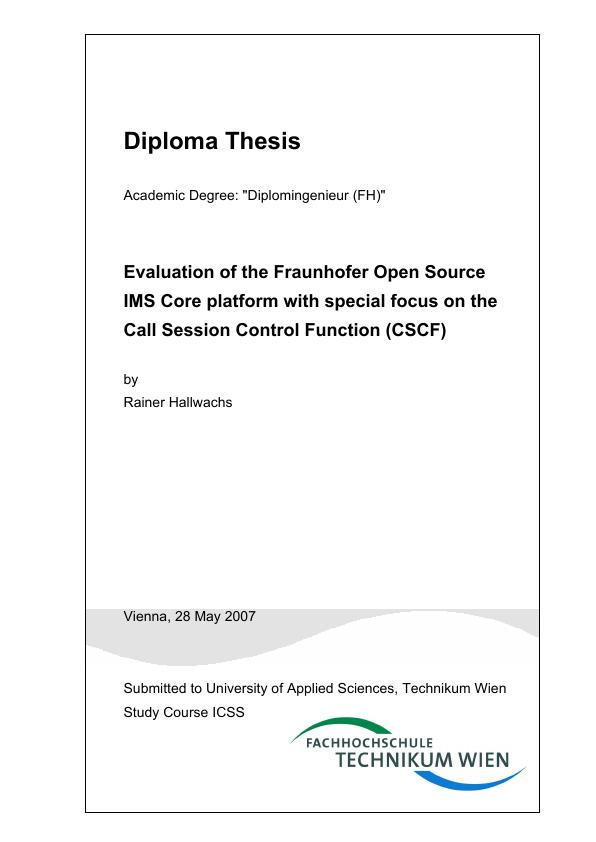Given the increasing penetration of Internet Protocol (IP) technologies and the tremendous growth in wireless data traffic, the telecom industry is evolving towards All-IP based Next Generation Networks (NGN). The Third Generation Partnership Project (3GPP) has specified an IP Multimedia Subsystem (IMS) in 3GPP Release 5 to support converged multimedia applications across both wireless and wireline devices. IMS provides full packet call control capabilities by using the Session Initiation Protocol (SIP). SIP has been chosen by 3GPP as the signaling protocol to handle user registrations and multimedia session management in the IMS. Using IP protocols defined by the Internet Engineering Task Force (IETF), IMS will merge cellular networks and the internet, offering new service capabilities for rapid service creation and deployment of integrated IP multimedia applications.
This diploma thesis provides an insight into the IP Multimedia Core Network, specifically focusing on its key element, the Call Session Control Function (CSCF). The CSCF serves as control point to manage all IMS sessions in the network, whether they are voice, video, data, messaging, gaming, or any other service. Moreover, this paper discusses the requirements identified by 3GPP to support SIP in cellular networks, and the extensions to the SIP protocol suite in order to fulfill them.
The practical part of the thesis evaluates the Open Source IMS Core platform of the Fraunhofer Institute FOKUS with respect to the CSCF which is based on the SIP Express Router (SER). The analysis describes the new modules and advanced functions of SER, required to cope with the extended version of SIP and to act as a CSCF for IMS purposes.
Inhaltsverzeichnis (Table of Contents in English)
- Abstract
- Kurzfassung
- Purpose of this Thesis
- Introduction
- I UNDERSTANDING IMS
- Principles of the IP Multimedia Subsystem
- What is the IP Multimedia Subsystem?
- IMS Specification Bodies: 3GPP and IETF
- High Level Requirements
- Differences to RFC 3261 SIP
- Registration
- Session Setup & Control
- Private Header Extensions to SIP for 3GPP
- P-Access-Network-Info Header
- P-Asserted-Identity Header
- P-Associated-URI Header
- P-Called-Party-ID Header
- P-Charging-Function-Addresses Header
- P-Charging-Vector Header
- P-Media-Authorization Header
- P-Preferred-Identity Header
- P-Visited-Network-ID Header
- Path Header
- Security-Client Header
- Security-Server Header
- Security-Verify Header
- Service-Route Header
- The IP Multimedia Subsystem Architecture
- The development of IP Multimedia Subsystem (IMS) and its role in Next Generation Networks (NGN).
- The importance of the Call Session Control Function (CSCF) within the IMS architecture.
- The specific requirements and extensions of the Session Initiation Protocol (SIP) for cellular networks.
- An evaluation of the Open Source IMS Core platform developed by the Fraunhofer Institute FOKUS, specifically focusing on the CSCF based on the SIP Express Router (SER).
- The challenges and opportunities presented by IMS and SIP in the context of converging multimedia applications.
- Purpose of this Thesis: Briefly introduces the purpose of the thesis and provides a roadmap for the subsequent chapters.
- Introduction: Provides context for the thesis by discussing the evolution of IP technologies and the rise of Next Generation Networks (NGN).
- Principles of the IP Multimedia Subsystem: This chapter dives into the core principles of the IP Multimedia Subsystem (IMS), including its architecture, key functionalities, and how it utilizes SIP for multimedia session control. It also discusses the differences between standard SIP and 3GPP extensions for cellular networks.
- The IP Multimedia Subsystem Architecture: This chapter explores the various components that make up the IMS architecture, including the CSCF, the Home Subscriber Server (HSS), and the Media Gateway Control Function (MGCF). It explains the interactions between these components and how they work together to support multimedia applications.
Zielsetzung und Themenschwerpunkte (Objectives and Key Themes in English)
This diploma thesis explores the IP Multimedia Core Network, with a particular focus on the Call Session Control Function (CSCF). It aims to provide an understanding of the CSCF's role in managing IMS sessions and how it interacts with SIP protocols to enable multimedia applications.Zusammenfassung der Kapitel (Chapter Summaries in English)
This preview does not contain information from the conclusion or final chapter to avoid spoilers. Please refer to the complete document for further details.Schlüsselwörter (Keywords in English)
This diploma thesis focuses on the IP Multimedia Subsystem (IMS), Call Session Control Function (CSCF), SIP, 3GPP, IETF, and Next Generation Networks (NGN). It also addresses the use of Open Source IMS Core platforms, specifically the SIP Express Router (SER) developed by the Fraunhofer Institute FOKUS.- Quote paper
- DI(FH) Mag. Rainer Hallwachs (Author), 2007, Evaluation of the Fraunhofer Open Source IMS Core platform with special focus on the Call Session Control Function (CSCF), Munich, GRIN Verlag, https://www.grin.com/document/134743



